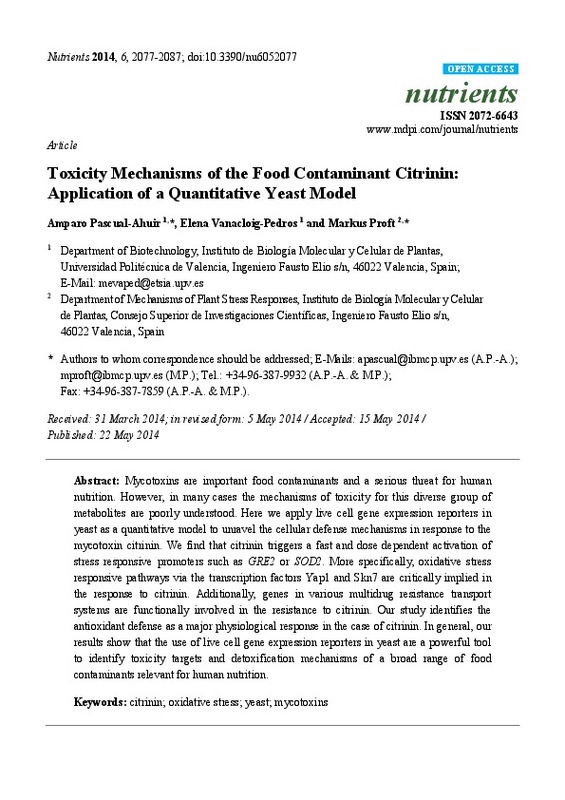Moretti, A., Susca, A., Mulé, G., Logrieco, A. F., & Proctor, R. H. (2013). Molecular biodiversity of mycotoxigenic fungi that threaten food safety. International Journal of Food Microbiology, 167(1), 57-66. doi:10.1016/j.ijfoodmicro.2013.06.033
Wu, F., Groopman, J. D., & Pestka, J. J. (2014). Public Health Impacts of Foodborne Mycotoxins. Annual Review of Food Science and Technology, 5(1), 351-372. doi:10.1146/annurev-food-030713-092431
Bennett, J. W., & Klich, M. (2003). Mycotoxins. Clinical Microbiology Reviews, 16(3), 497-516. doi:10.1128/cmr.16.3.497-516.2003
[+]
Moretti, A., Susca, A., Mulé, G., Logrieco, A. F., & Proctor, R. H. (2013). Molecular biodiversity of mycotoxigenic fungi that threaten food safety. International Journal of Food Microbiology, 167(1), 57-66. doi:10.1016/j.ijfoodmicro.2013.06.033
Wu, F., Groopman, J. D., & Pestka, J. J. (2014). Public Health Impacts of Foodborne Mycotoxins. Annual Review of Food Science and Technology, 5(1), 351-372. doi:10.1146/annurev-food-030713-092431
Bennett, J. W., & Klich, M. (2003). Mycotoxins. Clinical Microbiology Reviews, 16(3), 497-516. doi:10.1128/cmr.16.3.497-516.2003
Flajs, D., & Peraica, M. (2009). Toxicological Properties of Citrinin. Archives of Industrial Hygiene and Toxicology, 60(4). doi:10.2478/10004-1254-60-2009-1992
Bouslimi, A., Ouannes, Z., Golli, E. E., Bouaziz, C., Hassen, W., & Bacha, H. (2008). Cytotoxicity and Oxidative Damage in Kidney Cells Exposed to the Mycotoxins Ochratoxin A and Citrinin: Individual and Combined Effects. Toxicology Mechanisms and Methods, 18(4), 341-349. doi:10.1080/15376510701556682
El Golli, E., Hassen, W., Bouslimi, A., Bouaziz, C., Ladjimi, M. M., & Bacha, H. (2006). Induction of Hsp 70 in Vero cells in response to mycotoxins. Toxicology Letters, 166(2), 122-130. doi:10.1016/j.toxlet.2006.06.004
Kumar, R., Dwivedi, P. D., Dhawan, A., Das, M., & Ansari, K. M. (2011). Citrinin-Generated Reactive Oxygen Species Cause Cell Cycle Arrest Leading to Apoptosis via the Intrinsic Mitochondrial Pathway in Mouse Skin. Toxicological Sciences, 122(2), 557-566. doi:10.1093/toxsci/kfr143
Ribeiro, S. M. R., Chagas, G. M., Campello, A. P., & Kluppel, M. L. W. (1997). Mechanism of citrinin-induced dysfunction of mitochondria. V. Effect on the homeostasis of the reactive oxygen species. Cell Biochemistry and Function, 15(3), 203-209. doi:10.1002/(sici)1099-0844(199709)15:3<203::aid-cbf742>3.0.co;2-j
Chen, C.-C., & Chan, W.-H. (2009). Inhibition of Citrinin-Induced Apoptotic Biochemical Signaling in Human Hepatoma G2 Cells by Resveratrol. International Journal of Molecular Sciences, 10(8), 3338-3357. doi:10.3390/ijms10083338
Hsu, L.-C., Hsu, Y.-W., Liang, Y.-H., Lin, Z.-H., Kuo, Y.-H., & Pan, T.-M. (2012). Protective Effect of Deferricoprogen Isolated from Monascus purpureus NTU 568 on Citrinin-Induced Apoptosis in HEK-293 Cells. Journal of Agricultural and Food Chemistry, 60(32), 7880-7885. doi:10.1021/jf301889q
Iwahashi, H., Kitagawa, E., Suzuki, Y., Ueda, Y., Ishizawa, Y., Nobumasa, H., … Iwahashi, Y. (2007). Evaluation of toxicity of the mycotoxin citrinin using yeast ORF DNA microarray and Oligo DNA microarray. BMC Genomics, 8(1), 95. doi:10.1186/1471-2164-8-95
(2012). Scientific Opinion on the risks for public and animal health related to the presence of citrinin in food and feed. EFSA Journal, 10(3). doi:10.2903/j.efsa.2012.2605
Dos Santos, S. C. (2012). Yeast toxicogenomics: genome-wide responses to chemical stresses with impact in environmental health, pharmacology, and biotechnology. Frontiers in Genetics, 3. doi:10.3389/fgene.2012.00063
Rienzo, A., Pascual-Ahuir, A., & Proft, M. (2012). The use of a real-time luciferase assay to quantify gene expression dynamics in the living yeast cell. Yeast, 29(6), 219-231. doi:10.1002/yea.2905
Dolz-Edo, L., Rienzo, A., Poveda-Huertes, D., Pascual-Ahuir, A., & Proft, M. (2013). Deciphering Dynamic Dose Responses of Natural Promoters and Single cis Elements upon Osmotic and Oxidative Stress in Yeast. Molecular and Cellular Biology, 33(11), 2228-2240. doi:10.1128/mcb.00240-13
Garay-Arroyo, A., & Covarrubias, A. A. (1999). Three genes whose expression is induced by stress inSaccharomyces cerevisiae. Yeast, 15(10A), 879-892. doi:10.1002/(sici)1097-0061(199907)15:10a<879::aid-yea428>3.0.co;2-q
Proft, M. (2001). Regulation of the Sko1 transcriptional repressor by the Hog1 MAP kinase in response to osmotic stress. The EMBO Journal, 20(5), 1123-1133. doi:10.1093/emboj/20.5.1123
Mamnun, Y. M., Pandjaitan, R., Mahé, Y., Delahodde, A., & Kuchler, K. (2002). The yeast zinc finger regulators Pdr1p and Pdr3p control pleiotropic drug resistance (PDR) as homo- and heterodimers in vivo. Molecular Microbiology, 46(5), 1429-1440. doi:10.1046/j.1365-2958.2002.03262.x
Chagas, G. M., Campello, A. P., & Klüppel, M. L. W. (1992). Mechanism of citrinin-induced dysfunction of mitochondria. I. Effects on respiration, enzyme activities and membrane potential of renal cortical mitochondria. Journal of Applied Toxicology, 12(2), 123-129. doi:10.1002/jat.2550120209
Klarić, M. Š., Želježić, D., Rumora, L., Peraica, M., Pepeljnjak, S., & Domijan, A.-M. (2011). A potential role of calcium in apoptosis and aberrant chromatin forms in porcine kidney PK15 cells induced by individual and combined ochratoxin A and citrinin. Archives of Toxicology, 86(1), 97-107. doi:10.1007/s00204-011-0735-9
Yu, F.-Y., Liao, Y.-C., Chang, C.-H., & Liu, B.-H. (2006). Citrinin induces apoptosis in HL-60 cells via activation of the mitochondrial pathway. Toxicology Letters, 161(2), 143-151. doi:10.1016/j.toxlet.2005.08.009
Dönmez-Altuntas, H., Dumlupinar, G., Imamoglu, N., Hamurcu, Z., & Liman, B. C. (2007). Effects of the mycotoxin citrinin on micronucleus formation in a cytokinesis-block genotoxicity assay in cultured human lymphocytes. Journal of Applied Toxicology, 27(4), 337-341. doi:10.1002/jat.1209
Föllmann, W., Behm, C., & Degen, G. H. (2014). Toxicity of the mycotoxin citrinin and its metabolite dihydrocitrinone and of mixtures of citrinin and ochratoxin A in vitro. Archives of Toxicology, 88(5), 1097-1107. doi:10.1007/s00204-014-1216-8
Knasmuller, S., Cavin, C., Chakraborty, A., Darroudi, F., Majer, B. J., Huber, W. W., & Ehrlich, V. A. (2004). Structurally Related Mycotoxins Ochratoxin A, Ochratoxin B, and Citrinin Differ in Their Genotoxic Activities and in Their Mode of Action in Human-Derived Liver (HepG2) Cells: Implications for Risk Assessment. Nutrition and Cancer, 50(2), 190-197. doi:10.1207/s15327914nc5002_9
Thust, R., & Kneist, S. (1979). Activity of citrinin metabolized by rat and human microsome fractions in clastogenicity and SCE assays on Chinese hamster V79-E cells. Mutation Research/Genetic Toxicology, 67(4), 321-330. doi:10.1016/0165-1218(79)90028-4
Van Loon, A. P., Pesold-Hurt, B., & Schatz, G. (1986). A yeast mutant lacking mitochondrial manganese-superoxide dismutase is hypersensitive to oxygen. Proceedings of the National Academy of Sciences, 83(11), 3820-3824. doi:10.1073/pnas.83.11.3820
Delaunay, A., Isnard, A.-D., & Toledano, M. B. (2000). H2O2 sensing through oxidation of the Yap1 transcription factor. The EMBO Journal, 19(19), 5157-5166. doi:10.1093/emboj/19.19.5157
Toone, W. M., Morgan, B. A., & Jones, N. (2001). Redox control of AP-1-like factors in yeast and beyond. Oncogene, 20(19), 2336-2346. doi:10.1038/sj.onc.1204384
Heider, E. M., Harper, J. K., Grant, D. M., Hoffman, A., Dugan, F., Tomer, D. P., & O’Neill, K. L. (2006). Exploring unusual antioxidant activity in a benzoic acid derivative: a proposed mechanism for citrinin. Tetrahedron, 62(6), 1199-1208. doi:10.1016/j.tet.2005.10.066
[-]









